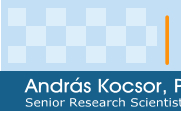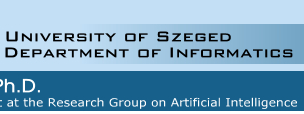|
|
Research Area
My scientific interest is the building of mathematic and algorithmic
models that demonstrably work well in the several fields of application
of artificial intelligence. From the view of algorithms machine learning
and data mining methods interest me and from the view of applications
speech technology, natural language processing, bioinformatics and the
problems of biometric recognition interest me.
Keywords
Artificial Intelligence, Machine Learning, Pattern recognition,
Statistical Learning Theory, Kernel Methods, Speech Recognition, Speech
Synthesis, Computer Aided Speech Impediment Therapy, Shape Theory, Shape
Description Problems, Similarity Measures, Numerical Mathematics, Eigenproblems,
Inequalities and Signal Processing.
My Scientific View
Simulating Human Intelligence - The Model Method
Creating intelligent machines is an old dream of mankind. It was realized
back in the middle of the last century that the construction of intelligent
systems requires automatized learning and decision making. These topics,
however, gave rise to considerable problems. "Learning" in the
machine learning sense means the application of the model method. That
is, we aim at creating models that correctly simulate human thinking.
The best way of doing this is to specify the model by means of a large
amount of training patterns; decisions regarding a new pattern are made
based on this model. But what is a "pattern"? Watanabe defines
pattern "as the opposite of a chaos; it is an entity, vaguely defined,
that could be given a name". For example, a speech signal, a portrait,
a piece of writing, a fingerprint or a DNA sequence can all be regarded
as patterns. And a typical example of decision making based on these patterns
is the identification of persons. At the present time, in most sophisticated
pattern recognition tasks humans still outperform computers. However,
in certain specific tasks that require only a limited level of intelligence,
computer models can do better than humans. In speech recognition, for
example, humans currently seem unbeatable, but when it comes to the classification
of phonemes (the building blocks of speech) based on 20-30 ms signal excerpts,
computers have the advantage. Increasing the pattern length from phonemes
to syllables, words or sentences, the task of classification becomes increasingly
involved, and the computer gradually loses its superiority. Several fields
of science like philosophy (as the science of sciences), physics, mathematics,
biology, chemistry and theoretical computer science have all contributed
to those tools that AI researchers build their models with. Such building
blocks are, for example, short and long-term memory, hierarchical model
construction, model hybridization, clustering, data-invariant methods,
optimization and approximation. The main problem currently is that, although
we are able to construct pattern classification systems that outperform
humans on simple subtasks with the help of these tools, the proper way
of organizing them into metastructures capable of solving more complex
-- and thus more "human" problems -- is still unknown. Another
critical issue deals with the massive parallelism of the human brain,
and the collection and handling of the enormous amount of training pattern
required for the tuning of the models. Fortunately, the digital revolution,
the rapid development of computers and finally the Internet have together
made many considerable innovations possible. In fact, these rapid developments
have made possible pattern recognition systems that can attain or even
exceed human performance.
András Kocsor
|
|





